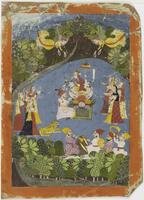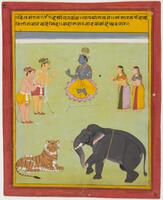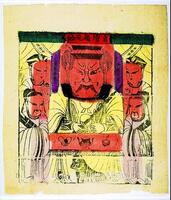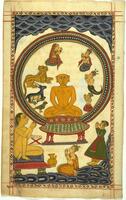9 Items in this Learning Collection
Collection Object
Collection Object
Collection Object
Collection Object
Collection Object
Collection Object
Copyright
All Rights Reserved
()
Jain Tirthankara and a monk with animal forest scene, no. 12 from a Digambara series
Accession Number
1975/2.178
Title
Jain Tirthankara and a monk with animal forest scene, no. 12 from a Digambara series
Artist(s)
Artist Unknown, India, Rajasthan, Sirohi School
Object Creation Date
18th century
Medium & Support
ink, opaque watercolor, and gold on paper
Dimensions
11 3/8 in x 7 3/8 in (28.89 cm x 18.73 cm);19 3/8 in x 14 3/8 in (49.21 cm x 36.51 cm)
Credit Line
Gift of Dr. and Mrs. Leo S. Figiel and Dr. and Mrs. Steven J. Figiel
Label copy
Gallery Rotations Fall 2012
Tirthankara and monk from Digambara Jain manuscript
India, Sirohi School
18th century
Ink, opaque watercolor, and gold on paper
Gift of Dr. and Mrs. Leo S. Figiel and Dr. and Mrs. Steven J. Figiel, 1975/2.178
Jina venerated by a monk, raja, and warriors from Digambara Jain manuscript
India, Sirohi School
18th century
Ink, opaque watercolor, and gold on paper
Gift of Dr. and Mrs. Leo S. Figiel and Dr. and Mrs. Steven J. Figiel, 1975/2.179
Jina and worshippers from Digambara Jain manuscript
India, Sirohi School
18th century
Ink, opaque watercolor, and gold on paper
Gift of Dr. and Mrs. Leo S. Figiel and Dr. and Mrs. Steven J. Figiel, 1975/2.180
In the Jain religion, book production reflects the integral relationship among the laity, monastic community, and the Jina, or enlightened Jain teacher. The dedication of sacred books for shrines is required of devotees, and while commissioning a book fulfills the lay obligation of charity, beholding a book helps the individual achieve the proper mental state for spiritual guidance. It was customary for a lay donor to commission a copy of a text for presentation to his spiritual teacher and ultimately to the temple library. Over the centuries, monastic libraries received great quantities of texts, which were employed in the instruction of monks and nuns, who were themselves discouraged from practicing the art of painting: one text expressly warns of the power of painting to arouse sensual feelings. In these colorful pages, both the golden-hued Jina seated on a simple throne and the monk who venerates him are naked, identifying them as Digambara (sky-clad) Jina.
Subject matter
The stark picture reflects essential features of the Jain faith: the ideal of renunciation, meditation on the Jina, and reliance on canonical texts. Dedication of sacred books is required of Jain devotees, and book production reflects the integral relationship between the laity, monastic community, and the Jina. Commissioning a book fulfills the lay obligation of charity, while beholding a book helps the individual achieve the proper mental state for spiritual guidance.
It was customary for a lay donor to commission a copy of a text for presentation to his spiritual teacher and ultimately to the monk’s temple library. Over the centuries, libraries received great quantities of texts, which were employed in the instruction of monks and nuns. Monks and nuns were discouraged, however, from practicing the art of painting: one text expressly warns them of the power of painting to arouse sensual feelings.
Physical Description
Two distinct registers divide a page in half. At the top, a yellow-orange colored nude jina sits in lotus position upon a three tiered throne [a patterned blue level at the bottom on feet, with an orange section with gold and red decoration and a green level at the top with gold vertical stripes]. He sits against a red background adorned with a pattern of three white dots. The background takes the shape of an elegant cusped arch with a green and white pattern along its outside with a gold pattern at its sides. To the right of the seated figure a nude Digambara monk sits with his legs folded and one knee up on a less elaborate throne with a lota or pot at the corner and a crossed bookstand to the side holding a book with some devanagari writing on it. He raises his right arm and holds his left to his ear.
Placed under a band of curving yellow stripes, the bottom register represents animals in a landscape. At the bottom are clumps of grass with four stylized mountain forms in blue at the right. Above the mountains stands a tiger facing a family of antelope striding towards him. The family consists of the blue male with his long spiraling horns and a yellow doe below him with a flesh-colored in front of her. Another small yellow fawn takes up the rear. Clumps of light blue and green grasses fill in the background.
Primary Object Classification
Unbound Work
Primary Object Type
leaf
Additional Object Classification(s)
Unbound Work
Collection Area
Asian
Rights
If you are interested in using an image for a publication, please visit http://umma.umich.edu/request-image for more information and to fill out the online Image Rights and Reproductions Request Form.
Keywords
Jainism
antelopes
books
grass (plant material)
kettles (vessels)
landscapes (environments)
men (male humans)
monks
mountains
nudes (representations)
pots (containers)
1975/2.178
Title
Jain Tirthankara and a monk with animal forest scene, no. 12 from a Digambara series
Artist(s)
Artist Unknown, India, Rajasthan, Sirohi School
Object Creation Date
18th century
Medium & Support
ink, opaque watercolor, and gold on paper
Dimensions
11 3/8 in x 7 3/8 in (28.89 cm x 18.73 cm);19 3/8 in x 14 3/8 in (49.21 cm x 36.51 cm)
Credit Line
Gift of Dr. and Mrs. Leo S. Figiel and Dr. and Mrs. Steven J. Figiel
Label copy
Gallery Rotations Fall 2012
Tirthankara and monk from Digambara Jain manuscript
India, Sirohi School
18th century
Ink, opaque watercolor, and gold on paper
Gift of Dr. and Mrs. Leo S. Figiel and Dr. and Mrs. Steven J. Figiel, 1975/2.178
Jina venerated by a monk, raja, and warriors from Digambara Jain manuscript
India, Sirohi School
18th century
Ink, opaque watercolor, and gold on paper
Gift of Dr. and Mrs. Leo S. Figiel and Dr. and Mrs. Steven J. Figiel, 1975/2.179
Jina and worshippers from Digambara Jain manuscript
India, Sirohi School
18th century
Ink, opaque watercolor, and gold on paper
Gift of Dr. and Mrs. Leo S. Figiel and Dr. and Mrs. Steven J. Figiel, 1975/2.180
In the Jain religion, book production reflects the integral relationship among the laity, monastic community, and the Jina, or enlightened Jain teacher. The dedication of sacred books for shrines is required of devotees, and while commissioning a book fulfills the lay obligation of charity, beholding a book helps the individual achieve the proper mental state for spiritual guidance. It was customary for a lay donor to commission a copy of a text for presentation to his spiritual teacher and ultimately to the temple library. Over the centuries, monastic libraries received great quantities of texts, which were employed in the instruction of monks and nuns, who were themselves discouraged from practicing the art of painting: one text expressly warns of the power of painting to arouse sensual feelings. In these colorful pages, both the golden-hued Jina seated on a simple throne and the monk who venerates him are naked, identifying them as Digambara (sky-clad) Jina.
Subject matter
The stark picture reflects essential features of the Jain faith: the ideal of renunciation, meditation on the Jina, and reliance on canonical texts. Dedication of sacred books is required of Jain devotees, and book production reflects the integral relationship between the laity, monastic community, and the Jina. Commissioning a book fulfills the lay obligation of charity, while beholding a book helps the individual achieve the proper mental state for spiritual guidance.
It was customary for a lay donor to commission a copy of a text for presentation to his spiritual teacher and ultimately to the monk’s temple library. Over the centuries, libraries received great quantities of texts, which were employed in the instruction of monks and nuns. Monks and nuns were discouraged, however, from practicing the art of painting: one text expressly warns them of the power of painting to arouse sensual feelings.
Physical Description
Two distinct registers divide a page in half. At the top, a yellow-orange colored nude jina sits in lotus position upon a three tiered throne [a patterned blue level at the bottom on feet, with an orange section with gold and red decoration and a green level at the top with gold vertical stripes]. He sits against a red background adorned with a pattern of three white dots. The background takes the shape of an elegant cusped arch with a green and white pattern along its outside with a gold pattern at its sides. To the right of the seated figure a nude Digambara monk sits with his legs folded and one knee up on a less elaborate throne with a lota or pot at the corner and a crossed bookstand to the side holding a book with some devanagari writing on it. He raises his right arm and holds his left to his ear.
Placed under a band of curving yellow stripes, the bottom register represents animals in a landscape. At the bottom are clumps of grass with four stylized mountain forms in blue at the right. Above the mountains stands a tiger facing a family of antelope striding towards him. The family consists of the blue male with his long spiraling horns and a yellow doe below him with a flesh-colored in front of her. Another small yellow fawn takes up the rear. Clumps of light blue and green grasses fill in the background.
Primary Object Classification
Unbound Work
Primary Object Type
leaf
Additional Object Classification(s)
Unbound Work
Collection Area
Asian
Rights
If you are interested in using an image for a publication, please visit http://umma.umich.edu/request-image for more information and to fill out the online Image Rights and Reproductions Request Form.
Keywords
Jainism
antelopes
books
grass (plant material)
kettles (vessels)
landscapes (environments)
men (male humans)
monks
mountains
nudes (representations)
pots (containers)
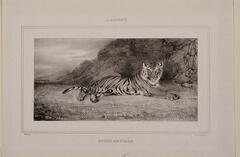
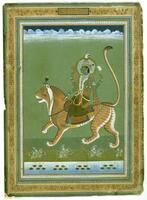
![Two distinct registers divide a page in half. At the top, a yellow-orange colored nude jina sits in lotus position upon a three tiered throne [a patterned blue level at the bottom on feet, with an orange section with gold and red decoration and a green level at the top with gold vertical stripes]. He sits against a red background adorned with a pattern of three white dots. The background takes the shape of an elegant cusped arch with a green and white pattern along its outside with a gold pattern at its sides. To the right of the seated figure a nude Digambara monk sits with his legs folded and one knee up on a less elaborate throne with a lota or pot at the corner and a crossed bookstand to the side holding a book with some devanagari writing on it. He raises his right arm and holds his left to his ear.<br />
Placed under a band of curving yellow stripes, the bottom register represents animals in a landscape. At the bottom are clumps of grass with four stylized mountain forms in blue at the right. Above the Two distinct registers divide a page in half. At the top, a yellow-orange colored nude jina sits in lotus position upon a three tiered throne [a patterned blue level at the bottom on feet, with an orange section with gold and red decoration and a green level at the top with gold vertical stripes]. He sits against a red background adorned with a pattern of three white dots. The background takes the shape of an elegant cusped arch with a green and white pattern along its outside with a gold pattern at its sides. To the right of the seated figure a nude Digambara monk sits with his legs folded and one knee up on a less elaborate throne with a lota or pot at the corner and a crossed bookstand to the side holding a book with some devanagari writing on it. He raises his right arm and holds his left to his ear.<br />
Placed under a band of curving yellow stripes, the bottom register represents animals in a landscape. At the bottom are clumps of grass with four stylized mountain forms in blue at the right. Above the](/media/W1siZiIsIjIwMjIvMDUvMjUvMXoxZ2ZnNHN6Zl9kZWZhdWx0LmpwZyJdLFsicCIsInRodW1iIiwiMjQweDIwMCJdXQ?sha=54d3764ea6247e3b)
